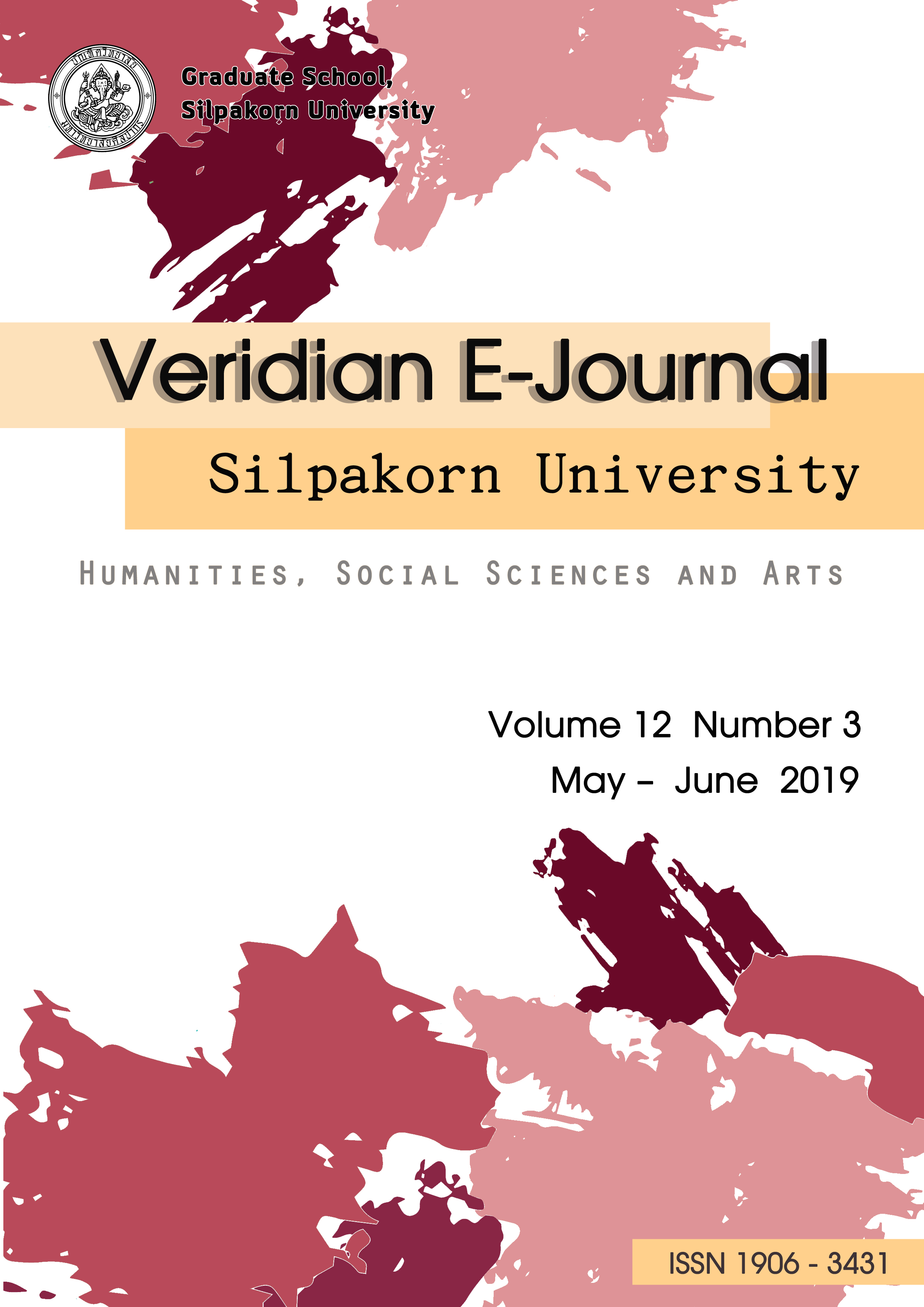การใช้นวัตกรรมการมีส่วนร่วมทางสังคมในการพัฒนาการท่องเที่ยวอย่างยั่งยืน กรณีศึกษา : ชุมชนบ้านถ้ำเสือ อำเภอแก่งกระจาน จังหวัดเพชรบุรี (Innovation of Social Engagement to Sustainable Tourism Development: A Case Study of Baan Tam Suea Community, Kaeng Krachan District, Petchaburi )
Main Article Content
Abstract
งานวิจัยมีวัตถุประสงค์ดังนี้ 1) คุณลักษณะของผู้นำชุมชนในการสร้างนวัตกรรมการมีส่วนร่วมทางสังคมสู่การท่องเที่ยวอย่างยั่งยืน 2) บทบาทของผู้นำของชาวบ้านในการสร้างนวัตกรรมการมีส่วนร่วมทางสังคมสู่การท่องเที่ยวอย่างยั่งยืน 3) นวัตกรรมการมีส่วนร่วมทางสังคมสู่การท่องเที่ยวอย่างยั่งยืน 4) แนวทาง การพัฒนาการท่องเที่ยวอย่างยั่งยืนของชุมชนบ้านถ้ำเสือ ตำบลแก่งกระจาน อำเภอแก่งกระจาน จังหวัดเพชรบุรี เป็นงานวิจัยเชิงคุณภาพ ใช้วิธีวิทยาแบบการสร้างทฤษฎีฐานราก ซึ่งเป็นวิธีวิทยาหนึ่งของกระบวนทัศน์ทางเลือก เก็บรวบรวมข้อมูลด้วยการสัมภาษณ์เชิงลึก โดยใช้แนวคำถามการสัมภาษณ์แบบกึ่งโครงสร้าง และวิธีการสังเกตแบบไม่มีส่วนร่วมผู้ให้ข้อมูลหลัก คือ ผู้นำชุมชน ชาวบ้าน ภาครัฐ ภาคเอกชน ตลอดจนผู้ที่มีส่วนเกี่ยวข้องจำนวน 35 คน
ผลการวิจัยพบว่า 1) คุณลักษณะของผู้นำชุมชนในการสร้างนวัตกรรมการมีส่วนร่วมทางสังคม ได้แก่ ผู้ช่วยดูแลทุกข์สุขในแนวทางที่ถูกต้อง ผู้ที่มีความน่าเชื่อมั่นในประชาชนและต้องการปรับปรุงตนเองอยู่เสมอ ผู้ที่พร้อมที่จะรับฟังเหตุผลและให้คำปรึกษา และผู้ที่ให้ความสำคัญต่อปัญหาของชุมชน 2) บทบาทของผู้นำของชาวบ้านในการสร้างนวัตกรรมการมีส่วนร่วมทางสังคมสู่การท่องเที่ยวอย่างยั่งยืน ได้แก่ บทบาทการมีส่วนร่วมในกระบวนการพัฒนาของประชาชนหรือชาวบ้าน บทบาทความคิดริเริ่มของชุมชน บทบาทเป็นตัวแทนการร่วมมือระหว่างภาครัฐกับประชาชน และบทบาทจัดตั้งกลุ่มและพัฒนากลุ่มในชุมชน 2.1) คุณลักษณะของชาวบ้าน ได้แก่ ร่วมศึกษาปัญหาและสาเหตุของปัญหาที่เกิดขึ้น ร่วมริเริ่มค้นคว้าและสร้างรูปแบบการพัฒนาเพื่อแก้ไขและลดปัญหาของชุมชนชน ร่วมตัดสินใจในการใช้ทรัพยากรที่มีอย่างจำกัดให้เป็นประโยชน์ต่อส่วนรวม และการร่วมลงทุนในกิจกรรมโครงการของชุมชนตามขีดความสามารถของตนเองและหน่วยงาน 3) นวัตกรรมการมีส่วนร่วมทางสังคมสู่การท่องเที่ยวอย่างยั่งยืน ได้แก่ 3.1) .การมีส่วนร่วมในการค้นหาปัญหาและประเด็นร่วมกัน 3.2) การมีส่วนร่วมในการวางแผนร่วมกัน 3.3) การมีส่วนร่วมในการปฏิบัติงานร่วมกัน 3.4) การมีส่วนร่วมในการตัดสินใจ 3.5) การมีส่วนร่วมในการติดตามประเมินผลร่วมกัน 3.6) การมีส่วนร่วมในการรับผลประโยชน์ 3.7) การมีส่วนร่วมในกิจกรรมความรับผิดชอบต่อสังคม 3.8) การมีส่วนร่วมในการสละทรัพยากร 3.9) การมีส่วนร่วมในการสร้างจิตสำนึก 3.10)การมีส่วนร่วมในการพัฒนาโครงการให้ยั่งยืนในอนาคต 3.11) การมีส่วนร่วมในการเสริมสร้างความคิดของคนรุ่นใหม่ ) แนวทางการพัฒนาการท่องเที่ยวอย่างยั่งยืนของชุมชน ได้แก่ ระยะการฟื้นฟู ระยะการลงมือปฏิบัติ และระยะการนำไปสู่ความยั่งยืน
This research is qualitative research. The objective is to 1) feature of community leaders to create innovative, engaging way to sustainable tourism, 2) the characteristics of people in innovative ways to engage the community to Sustainable Tourism 3) innovative social engagement towards sustainable tourism 4) Guidelines for Sustainable Tourism Development of Ban Tam Suea Community, Kaeng Krachan District, Phetchaburi Province.
The results of the research were as follows: 1) The characteristics of community leaders in creating innovation, social participation, including assistants to take care of suffering in the right way People who have confidence in the people and want to improve themselves always Those who are ready to listen to reason and give advice And those who give importance to the problems of the community Community initiative role The role is to represent the cooperation between the government and the public. And the role of the group and community development group 2.1) The characteristics of the villagers include studying the problems and causes of the problems. Participate in initiating research and creating development models to solve and reduce the problems of the community. Participate in the use of limited resources to benefit the public. And joint investment in community project activities according to their own capabilities and agencies 3) Social participation in sustainable tourism, including 3.1) Participation in finding problems and issues together 3.2) Participation in joint planning 3.3) Participation in joint operations 3.4) Participation in decision-making 3.5) Participation in joint assessment follow-up 3.6) Having Significant numbers of beneficiaries 3.7) Engaging in activities CSR 3.8) Participation in resource investing 3.9) Participation in the creation of consciousness. 3.10) Participation in the development of sustainable projects in the future 3.11) Participation in enhancing the ideas of the new generation) Sustainable tourism development methods of the community include the rehabilitation period Practice period And lead to sustainability.
